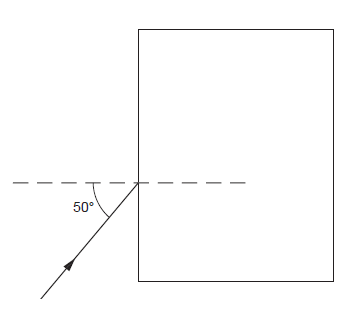Physics > Waves > Refraction: IGCSE past papers
The calculations shown in this section are based on the simplified theory of refraction (explained here), according to the IGCSE syllabus.

1)(a) A ray of monochromatic red light is incident on a glass block at an angle of 50º (image above).
(i) State what is meant by monochromatic light.
Answer: Mono - one; chromos means colour. So, it means light of a single colour (or frequency)
(ii) For this red ray the refractive index of the glass is 1.52. Calculate the angle of refraction
for the ray.
Answer: We need to use Snell´s law:

i = 50
sin i = 0.76
n = 1.52
So, 1.52 = 0.76 / sin r => sin r = 0.76 / 1.52 = 0.5
sin r = 0.5 => r = sin -1 0.5 = 30º
(iii) Without measuring angles, use a ruler to draw the approximate path of the ray in the
glass block and emerging from the block.
Answer: The light bends towards the normal as it enters the glass and then bends away when it leaves, so that it leaves parallel to the incident ray.
(b) The red ray in Fig. 7.1 is replaced by a ray of monochromatic violet light. For this violet ray the
refractive index of the glass is 1.54. The speed of light in air is 3.00 × 108 m / s.
(i) Calculate the speed of the violet light in the glass block.
Answer: Using the definition of n:
n = speed of light in a vacuum / speed of light in the material
1.54 = 3.00 × 108 / speed of the violet light in the glass block
speed of the violet light in the glass block = 3.00 × 108 / 1.54 = 1.95 × 108 m/s
(ii) Use a ruler to draw the approximate path of this violet ray in the glass block and emerging
from the block. Make sure this path is separated from the path drawn for the red light in
(a)(iii). Mark both parts of this path with the letter V.
Answer: The refractive index of violet light is larger so it will bend more than the red light. Both rays exit the glass following a direction parallel to the incident ray.
